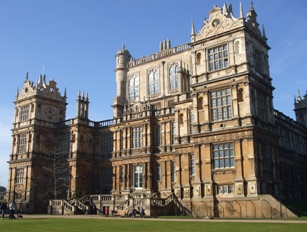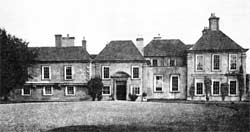Middleton Collection: Family Seats
The manor of Wollaton was bought around 1314-19 from Sir Roger Morteyn. The medieval manor house at Wollaton was situated near the church. In 1550 there were 39 rooms in the main house, plus outbuildings. The hall was converted into cottages in the early sixteenth century, and stood until 1671.

Photograph of Wollaton Hall, Nottinghamshire, 2008
The present Wollaton Hall was built from scratch on the orders of Sir Francis Willoughby from 1580-88, and probably cost around £8,000. It was designed and overseen by Robert Smythson. The hall became the principal family seat of the Willoughby family, who were created Barons Middleton in 1712.
Francis, Thomas and Cassandra Willoughby made some changes in the late seventeenth and early centuries. Major alterations were made by the 6th Baron Middleton and the architect Jeffrey Wyatville in the early nineteenth century. The Hall was sold to Nottingham Corporation for £200,000 by the 11th Baron Middleton in 1925, and has been used since 1926 as a Natural History Museum.

North side of Middleton Hall, Warwickshire, 1908 [Acc 6]
Middleton in Warwickshire was acquired by the Willoughby family around 1435 through the marriage of Sir Hugh Willoughby (d 1448) to Margaret de Freville. It was the favoured residence of Francis Willoughby II (1588-1665) and his son Francis Willughby the naturalist (1635-1672).
It has a medieval and Tudor core, including a sixteenth century Great Hall, with a large west wing added in the Georgian period. The Hall was sold in 1925 to John Averill. During the twentieth century it became dilapidated. Since 1980, the Hall has been restored and re-opened to the public for tours, exhibitions, weddings and functions, by the Middleton Hall Trust.
Birdsall House near Malton, East Yorkshire, was acquired through the marriage of Thomas Willoughby (1694-1742), father of the 5th Baron Middleton, to Elizabeth Sotheby. The 6th Baron Middleton built a new church at Birdsall in 1824. Birdsall House became particularly favoured as the family's principal residence from the time of the 8th Baron (who succeeded in 1856) onwards.
Settrington House near Malton, East Yorkshire, was built in the late eighteenth century and was formerly the home of the Masterman family. It was purchased by the 6th Baron Middleton in 1826. In 1892 it was occupied by Julia, Dowager Lady Middleton. It was sold by the 11th Baron in 1938 to Samuel Storey, M.P. The house is still owned by the Storey family, with its gardens occasionally opened to the public.
The core of the Willoughby family estate by the early seventeenth century were the 'six manors' inherited by Sir Percival Willoughby, of Wollaton, Sutton Passeys, Cossall, and Trowell in Nottinghamshire, and Middleton and Kingsbury in Warwickshire, plus other estates chiefly in Nottinghamshire. These were reduced to four by the next generation, as Cossall and Kingsbury passed to Sir Percival's second son Edward Willoughby. However, further estates in Nottinghamshire, Yorkshire and elsewhere were acquired by marriage, making the geographical spread of the family's estates very extensive by the nineteenth century. Most of the family's estates outside Yorkshire were sold off in the 1920s and 1930s following the deaths of the 9th and 10th Barons. The main Willoughby properties in each county were as follows:
Cheshire
- Smallwood. Records from this estate survive in the Middleton collection from 1330-1608 held in Manuscripts and Special Collections at the University of Nottingham.
Derbyshire
- Risley and Mapperley, acquired in the 14th century through the marriage of Sir Richard Willoughby (d 1362) to the daughter of Sir Roger Morteyn. Both disposed of by the 17th century.
- Stanton by Dale and Ilkeston. Part of the Trowell and Cossall 'South Nottinghamshire' estates.
- Totley. Acquired by the mid-16th century, part of the Honour of Peverel. Sold 1867.
Dorset
- Woodlands, acquired through the marriage of Sir Edward Willoughby (d 1541) to Anne Filliol. Passed to Henry Hastings, son-in-law of Sir Francis Willoughby in the late 16th century.
- Winterborne Zelston/Zelstone, acquired through the marriage of Sir Edward Willoughby (d 1541) to Anne Filliol. Sold to Thomas Hannam, 1582.
- Langton Wallis, acquired through the marriage of Sir Edward Willoughby (d 1541) to Anne Filliol. Passed to Sir Christopher Hatton, late 16th century.
- Steeple Hall, acquired through the marriage of Sir Edward Willoughby (d 1541) to Anne Filliol. Disposed of by early 17th century.
Gloucestershire
- Westerleigh, Henbury etc., held jointly with the Colston family. In possession of the Willoughbys by 1741. Sold in 1858.
Hertfordshire
- Standon, acquired through the marriage of Sir Edward Willoughby (d 1541) to Anne Filliol.
Kent
- Chiddingstone, Chevening, Penshurst, Selling, Ightham and Sundridge. Held by the Willoughby family of Bore Place, Kent, and inherited by Sir Percival Willoughby (d 1643), son-in-law of Sir Francis Willoughby of Wollaton. The Kent properties had passed away from the Willoughby family of Wollaton, or been sold, by the mid-17th century.
Lincolnshire
- Dunsby, acquired through the marriage of Sir Richard Willoughby (d 1362) to the daughter of Sir Roger Morteyn. Disposed of by late 16th century.
- Stapleford and Carlton-le-Moorland, acquired through the marriage of Thomas Willoughby, 1st Baron Middleton, to Elizabeth Rothwell in 1691. Sold 1920s.
Middlesex
- Holborn, bought by Sir Henry Willoughby (1451-1528), and passed in around 1570 to George Fox alias Willoughby, illegitimate brother of Sir Francis Willoughby.
Nottinghamshire
- Willoughby-on-the-Wolds, bought 13th century, sold early 17th century .
- Wollaton and Sutton Passeys, bought around 1314-19 from Sir Roger Morteyn. Sold 1920s.
- Cossall manor, 14th century acquisition, passed to Edward Willoughby in the seventeenth century.
- Trowell, Cossall, Aspley, Lenton, Radford, Bramcote and Beeston (the 'South Nottinghamshire Estates'). Acquired from the 14th century onwards. Remaining portions sold 1920s.
- Gunthorpe and Lowdham, acquired through the marriage of Sir Hugh Willoughby (d 1448) to Margaret de Freville. Not featured in the Middleton collection after 1607.
- South Muskham and South Carlton, bequeathed to Francis Willughby by Sir William Willoughby of Selston in 1671. The subject of extensive lawsuits by Sir Beaumont Dixie, Sir William's brother-in-law, and his widow. Sold 1924-1925.
- Newark, acquired through the marriage of Thomas Willoughby, 1st Baron Middleton, to Elizabeth Rothwell in 1691. Sold 1867.
- Caunton, various estates bought from the mid-17th century onwards. Sold 1867.
- West Leake. Various portions bought in the mid-late 18th century. Sold 1867.
- North Wheatley, Saundby, Sturton-le-Steeple and South Leverton, acquired through the marriage of Thomas Willoughby, 1st Baron Middleton, to Elizabeth Rothwell in 1691. Parts of Leverton sold 1867. Remaining portions sold 1921.
Ross-shire
- Applecross, bought 1862. Sold 1929.
Warwickshire
- Middleton, acquired around 1435 through the marriage of Sir Hugh Willoughby (d 1448) to Margaret de Freville. Sold in 1925.
- Kingsbury. Bulk passed to Edward Willoughby in the seventeenth century. Other portions, part of the Middleton estate, sold in 1925.
- Hurley, sold 1867.
Yorkshire
- Birdsall, acquired through the marriage of Thomas Willoughby (d 1742), father of the 5th Baron Middleton, to Elizabeth Sotheby.
- Wharram Percy, bought 1833.
Next page: Middleton Family biographies